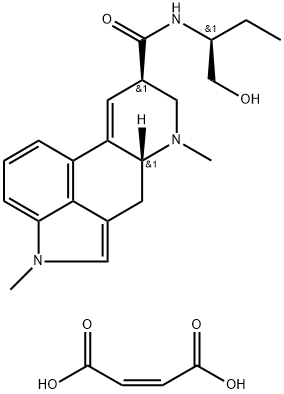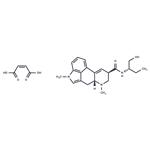Description
Methysergide is an agonist of the serotonin (5-HT) receptor subtype 5-HT
1 and an antagonist of 5-HT
2 receptors. It binds to recombinant human 5-HT
1A (K
D = 23.44 nM), 5-HT
1E (K
i = 229.09 nM), 5-HT
1F (K
i = 33.88 nM), and rodent 5-HT
1B receptors (K
D = 1,513.56 nM). It also binds to recombinant human 5-HT
2A (K
i = 2.69 nM) and 5-HT
2C receptors (K
D = 1.26 nM) and is an insurmountable antagonist at 5-HT
2B receptors. It inhibits vasoconstriction induced by 5-HT in isolated postmortem human basilar arterial spiral strips (pA
2 = 8.07). Methysergide decreases external carotid blood flow in a dose-dependent manner in vagosympathectomized dogs, an effect that is inhibited by the 5-HT
1B/1D receptor antagonist GR127935 . It has antinociceptive activity in mouse models of pain induced by intrathecal injection of substance P , glutamate, NMDA , AMPA , or kainic acid. Methysergide reduces zymosan-induced paw edema in rats when administered at a dose of 10 mg/kg. Formulations containing methysergide were previously used in the prevention and treatment of vascular headaches.
Originator
Sansert ,Sandoz,US,1962
Uses
Methysergide maleate salt has been used as a serotonin (5HT) receptor antagonist to evaluate the potential systemic effects of methysergide (METH) and 5-HT infusions on production and milk composition in multiparous Holstein cows. It may also be used as a serotonin receptor blocker to identify the serotonergic receptor type involved in the direct excitation of mitral cells in the main olfactory bulb.
Definition
ChEBI: Methysergide maleate is an ergoline alkaloid.
Manufacturing Process
As described in US Patent 3,218,324, 0.9 part of potassium are dissolved in 500 parts by volume of liquid ammonia, then oxidized with ferric nitrate to potassium amide, after which 4.85 parts of lysergic acid-1'-hydroxybutylamide-2' are dissolved in the obtained mixture. After 15 minutes there are added to the obtained yellow solution 4.1 parts of methyl iodide in 5 parts by volume of ether, the mixture being allowed to stand for 30 more minutes at -60°C. The liquid ammonia is thereupon evaporated and the dry residue is shaken out between water and chloroform. The mixture of bases which remains after the evaporation of the chloroform is chromatographed on a column of 250 parts of aluminum oxide, the desired 1-methyl-lysergic acid-1'- hydroxy-butylamide-2' being washed into the filtrate with chloroform and chloroform-0.2% ethanol. The 1-methyl-lysergic acid-1'hydroxy-butylamide-2' crystallizes from chloroform in the form of plates which melt at 194° to 196°C. Reaction with maleic acid gives the dimaleate, melting at 187° to 188°C.
brand name
Sansert (Novartis).
Therapeutic Function
Migraine therapy
Biological Activity
Mixed 5-HT 1 /5-HT 2 receptor antagonist.
Biochem/physiol Actions
Methysergide maleate, also known as sansert, is a semisynthetic ergot alkaloid ergometrine derivative. Methysergide is a serotonin 1(5-HT1) receptor agonist and a nonselective 5-HT2 and 5-HT7 serotonin receptor antagonist. Methysergide maleate is used as a pharmacological agent to treat migraines and other vascular headaches. But, prolonged and uncontrolled use of this drug may cause Leriche′s syndrome, angina pectoris, acute ischemia of the limbs. In addition, gastrointestinal side effects, such as abdominal cramps, nausea, and diarrhea have also been observed in few patients.
Safety Profile
Poison by ingestion and
intravenous routes. Experimental
reproductive effects. Human mutation effects reported. When heated to
decomposition it emits toxic fumes of NOx.


